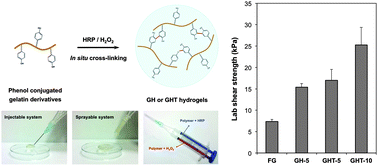In situ forming gelatin-based tissue adhesives and their phenolic content-driven properties
Abstract
The present study describes enzymatically cross-linked gelatin-based hydrogels as in situ forming

* Corresponding authors
a
Department of Molecular Science and Technology, Ajou University, 5 Woncheon, Yeongtong, Suwon, Republic of Korea
E-mail:
kdp@ajou.ac.kr
Fax: +82-31-219-1592
Tel: +82-31-219-1846
b Department of Biomedical Engineering, Vanderbilt University, VU Station B 351631, Nashville, TN 37235, USA
The present study describes enzymatically cross-linked gelatin-based hydrogels as in situ forming

 Please wait while we load your content...
Something went wrong. Try again?
Please wait while we load your content...
Something went wrong. Try again?
Y. Lee, J. W. Bae, D. H. Oh, K. M. Park, Y. W. Chun, H. Sung and K. D. Park, J. Mater. Chem. B, 2013, 1, 2407 DOI: 10.1039/C3TB00578J
To request permission to reproduce material from this article, please go to the Copyright Clearance Center request page.
If you are an author contributing to an RSC publication, you do not need to request permission provided correct acknowledgement is given.
If you are the author of this article, you do not need to request permission to reproduce figures and diagrams provided correct acknowledgement is given. If you want to reproduce the whole article in a third-party publication (excluding your thesis/dissertation for which permission is not required) please go to the Copyright Clearance Center request page.
Read more about how to correctly acknowledge RSC content.
 Fetching data from CrossRef.
Fetching data from CrossRef.
This may take some time to load.
Loading related content
